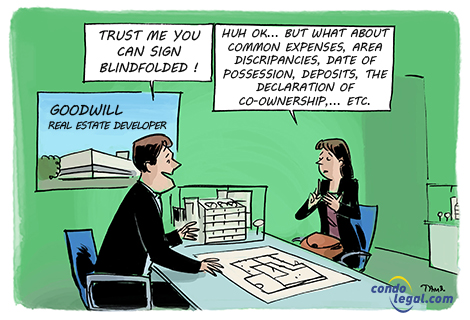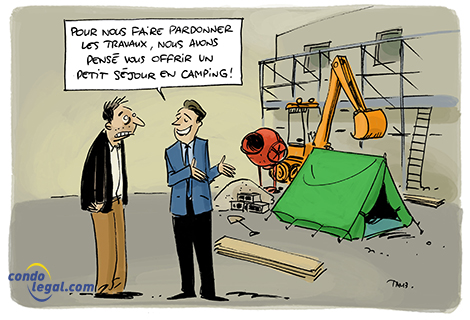 March 10th 2022 - The pre-acceptance inspection is a critical step in the process of acquiring a new property. A thorough and careful inspection is the best way to protect buyers from any unforeseen issues. In this article, we will tell you everything you need to know about the pre-acceptance inspection of the private portions and common areas of your co-owned property.
March 10th 2022 - The pre-acceptance inspection is a critical step in the process of acquiring a new property. A thorough and careful inspection is the best way to protect buyers from any unforeseen issues. In this article, we will tell you everything you need to know about the pre-acceptance inspection of the private portions and common areas of your co-owned property.
 LITTLE REMINDER : Let us start by reminding you that in the new co-owned property market, the mandatory guarantee plan administered by Garantie de construction résidentielle (GCR) covers buildings held in divided co-ownership that have no more than four private portions stacked one above the other, as well as detached, semi-detached or row-type single-family houses held in co-ownership. “Condo towers” are not covered by the mandatory guarantee plan.
LITTLE REMINDER : Let us start by reminding you that in the new co-owned property market, the mandatory guarantee plan administered by Garantie de construction résidentielle (GCR) covers buildings held in divided co-ownership that have no more than four private portions stacked one above the other, as well as detached, semi-detached or row-type single-family houses held in co-ownership. “Condo towers” are not covered by the mandatory guarantee plan.
1) Private portion pre-acceptance inspection
The first thing you need to know is that the private portion pre-acceptance inspection (for condo units) is mandatory under the Regulation. The inspection is an opportunity for you to familiarize yourself with your future home and to make sure the finishes and materials are as described in the contract. Were the right kitchen countertops put in? Are the ceramic tiles on your bathroom floor the ones you chose? The inspection is also a way to learn more about the maintenance of the components of your condo, such as the air exchanger and air conditioner.
In more concrete terms, the purpose of the pre-acceptance inspection is to examine the unit’s elements and identify any unfinished work or visible construction defects.
How does it work?
The co-owner and the contractor inspect the private portion together. They go over each part of the condo to review its condition. Garantie de construction résidentielle (Residential Construction Guarantee) GCR put together an inspection checklist, which has been approved by the Régie du bâtiment du Québec (RBQ), to help you with this step. You can find it here.
Any elements that need to be corrected or finalized must be carefully noted in writing. We also recommend taking photographs or videos. The co-owner and the contractor then agree on a completion date for the end of work, no later than six months after the pre-acceptance inspection.
Pro tip: Bring a professional with you
Most buyers, with few exceptions, are not well versed in the jargon and technical concepts of construction. For this reason, GCR recommends that you bring an unbiased building professional, such as an architect, a technologist or an engineer, along for the private portion pre-acceptance inspection. Make sure your professional is a member in good standing with a professional order.
2) Common area pre-acceptance inspection
The pre-acceptance inspection of common portions is also mandatory. The objective here is to examine all the elements of the building’s common areas in order to identify any unfinished work or construction defects.
How does it work?
Once the building’s independent syndicate of co-owners and the known co-owners receive an end of work notification from the contractor, the syndicate must hire a building professional to carry out the pre-acceptance inspection of the common areas. Unlike the private portion pre-acceptance inspection, for which you may choose whether or not you want to have a professional with you, the syndicate is obligated to have a building professional declare acceptance of the building’s common areas and agree on the date on which work on the common areas will be completed. The building professional (architect, engineer or technologist) chosen by the syndicate must have training in the field of engineering or construction and be a member of a professional order.
The building professional, the contractor and the syndicate of co-owners are all present for this inspection. GCR put together an inspection checklist, which has been approved by the Régie du bâtiment du Québec (RBQ), to help you with this step. You can find it here.
The building professional will carefully write down any items that need to be corrected or finalized and agree with the contractor on a new completion date for the work to be done.
3) Transparency of the pre-acceptance inspection
The pre-acceptance inspection of the private portion and common areas must be free of any undue pressure from the contractor. Under no circumstances should the contractor fill out the pre-acceptance inspection form ahead of time.
Any necessary corrections or unfinished work identified during the pre-acceptance inspection must be indicated on the form by checking the “Acceptance – with reservations” box and completing the “Date of the end of the work” section. It is important to note that this new date must be no more than six months after the pre-acceptance inspection date.
If no visible defects or other elements are found, check the “Acceptance – without reservation” box. All parties must make sure they agree with the information on the form before signing it.





